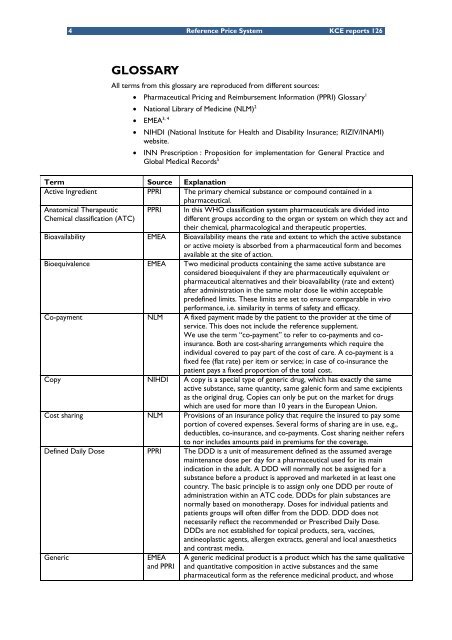The reference price system and socioeconomic differences in ... - KCE
The reference price system and socioeconomic differences in ... - KCE
The reference price system and socioeconomic differences in ... - KCE
You also want an ePaper? Increase the reach of your titles
YUMPU automatically turns print PDFs into web optimized ePapers that Google loves.
4 Reference Price System <strong>KCE</strong> reports 126<br />
GLOSSARY<br />
All terms from this glossary are reproduced from different sources:<br />
• Pharmaceutical Pric<strong>in</strong>g <strong>and</strong> Reimbursement Information (PPRI) Glossary 1<br />
• National Library of Medic<strong>in</strong>e (NLM) 2<br />
3, 4<br />
• EMEA<br />
• NIHDI (National Institute for Health <strong>and</strong> Disability Insurance; RIZIV/INAMI)<br />
website.<br />
• INN Prescription : Proposition for implementation for General Practice <strong>and</strong><br />
Global Medical Records 5<br />
Term Source Explanation<br />
Active Ingredient PPRI <strong>The</strong> primary chemical substance or compound conta<strong>in</strong>ed <strong>in</strong> a<br />
Anatomical <strong>The</strong>rapeutic<br />
Chemical classification (ATC)<br />
pharmaceutical.<br />
PPRI In this WHO classification <strong>system</strong> pharmaceuticals are divided <strong>in</strong>to<br />
different groups accord<strong>in</strong>g to the organ or <strong>system</strong> on which they act <strong>and</strong><br />
their chemical, pharmacological <strong>and</strong> therapeutic properties.<br />
Bioavailability EMEA Bioavailability means the rate <strong>and</strong> extent to which the active substance<br />
or active moiety is absorbed from a pharmaceutical form <strong>and</strong> becomes<br />
available at the site of action.<br />
Bioequivalence EMEA Two medic<strong>in</strong>al products conta<strong>in</strong><strong>in</strong>g the same active substance are<br />
considered bioequivalent if they are pharmaceutically equivalent or<br />
pharmaceutical alternatives <strong>and</strong> their bioavailability (rate <strong>and</strong> extent)<br />
after adm<strong>in</strong>istration <strong>in</strong> the same molar dose lie with<strong>in</strong> acceptable<br />
predef<strong>in</strong>ed limits. <strong>The</strong>se limits are set to ensure comparable <strong>in</strong> vivo<br />
performance, i.e. similarity <strong>in</strong> terms of safety <strong>and</strong> efficacy.<br />
Co-payment NLM A fixed payment made by the patient to the provider at the time of<br />
service. This does not <strong>in</strong>clude the <strong>reference</strong> supplement.<br />
We use the term “co-payment” to refer to co-payments <strong>and</strong> co<strong>in</strong>surance.<br />
Both are cost-shar<strong>in</strong>g arrangements which require the<br />
<strong>in</strong>dividual covered to pay part of the cost of care. A co-payment is a<br />
fixed fee (flat rate) per item or service; <strong>in</strong> case of co-<strong>in</strong>surance the<br />
patient pays a fixed proportion of the total cost.<br />
Copy NIHDI A copy is a special type of generic drug, which has exactly the same<br />
active substance, same quantity, same galenic form <strong>and</strong> same excipients<br />
as the orig<strong>in</strong>al drug. Copies can only be put on the market for drugs<br />
which are used for more than 10 years <strong>in</strong> the European Union.<br />
Cost shar<strong>in</strong>g NLM Provisions of an <strong>in</strong>surance policy that require the <strong>in</strong>sured to pay some<br />
portion of covered expenses. Several forms of shar<strong>in</strong>g are <strong>in</strong> use, e.g.,<br />
deductibles, co-<strong>in</strong>surance, <strong>and</strong> co-payments. Cost shar<strong>in</strong>g neither refers<br />
to nor <strong>in</strong>cludes amounts paid <strong>in</strong> premiums for the coverage.<br />
Def<strong>in</strong>ed Daily Dose PPRI <strong>The</strong> DDD is a unit of measurement def<strong>in</strong>ed as the assumed average<br />
ma<strong>in</strong>tenance dose per day for a pharmaceutical used for its ma<strong>in</strong><br />
<strong>in</strong>dication <strong>in</strong> the adult. A DDD will normally not be assigned for a<br />
substance before a product is approved <strong>and</strong> marketed <strong>in</strong> at least one<br />
country. <strong>The</strong> basic pr<strong>in</strong>ciple is to assign only one DDD per route of<br />
adm<strong>in</strong>istration with<strong>in</strong> an ATC code. DDDs for pla<strong>in</strong> substances are<br />
normally based on monotherapy. Doses for <strong>in</strong>dividual patients <strong>and</strong><br />
patients groups will often differ from the DDD. DDD does not<br />
necessarily reflect the recommended or Prescribed Daily Dose.<br />
DDDs are not established for topical products, sera, vacc<strong>in</strong>es,<br />
ant<strong>in</strong>eoplastic agents, allergen extracts, general <strong>and</strong> local anaesthetics<br />
Generic EMEA<br />
<strong>and</strong> PPRI<br />
<strong>and</strong> contrast media.<br />
A generic medic<strong>in</strong>al product is a product which has the same qualitative<br />
<strong>and</strong> quantitative composition <strong>in</strong> active substances <strong>and</strong> the same<br />
pharmaceutical form as the <strong>reference</strong> medic<strong>in</strong>al product, <strong>and</strong> whose
















